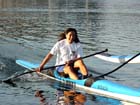|

How to "Fly the Ama"
Jude Turczynski
Developed years ago by the top paddlers in Hawaii, "Flying the Ama" has become the standard Outrigger version of Surfing's "Hang Ten." These days, many "placing" racers everywhere fly the ama when crossing the finish line. During races and workouts, it's fun and exciting to catch a wave and ride it without taking a stroke for many yards, all the while flying that ama high as you can...bracing ever so lightly on your paddle as it skims over the water. It's a balancing act of confidence verses wet hair. My belief and hope is that this is the first of many tricks to come from the adventurous pioneers of Outrigger sport.
Learning to fly the ama is fun, simple and wet. Technique is based on the standard paddle "Brace" used by Surfskiers, Kayakers and marathon canoeists alike. Only here, we use much more control to keep the canoe in balance without placing too much pressure on the dragging blade.
Body & paddle position are important to learning quickly and with "fewer" dunks into the drink. When bracing, sit in the normal paddling position and grip the paddle exactly as you would when paddling on the right side. Place the blade behind your seat, with the paddle's front face "down" and just above the water. Rest your left fist against your thigh, near your knee. (Later, you'll learn to rest the shaft against your thigh, and let go of the top-grip!) Keep the blade "out" away from the canoe, so you'll have leverage against your falling weight. And, tilt the leading edge of the blade up higher than the trailing edge so it will "skim" the surface instead of "dive" under and pull you over.

Click on picture to see details on body/paddle position
I hope you realize, "the canoe has to be moving in order to fly the ama or effectively brace against your paddle." If you're not moving, you'll go, "plop!" And, it's best to learn on glassy water rather than waves, for obvious reasons.
Now that you've got the whole position thing down, it's time to get the ama up, off the water. First, get the canoe up to full speed. Then, assume the "Brace" position. And, now slowly begin pressuring your right hip down, or just lean to the right. As the canoe just begins to "huli" (go over), brace on your paddle to prevent it. Repeat this over and over until you become confident in your brace. As you become more confident, watch to see how high you can fly the ama, and how long you can keep it up. Now as your skill develops, try to lean less on your brace. Balance the canoe, so that your paddle is barely touching the water, causing very little splash as your blade gently skims the surface.
By now, you'll have made lots of use of your canoe leash and will be plenty quick at climbing back on from the right. You may need a couple hours of practice, just to stay up for several seconds. It's like learning to ride a bike. Once you learn, you'll never forget. As you become more proficient, try bracing on a moment's notice. Learn to switch to a bracing position quickly from paddling on the left. So that now, after days of practice, you're ready to try it on some waves.

Click on picture to see details on body/paddle position
So, now you're able to fly it [ama] in pretty rough water...eh? It's time to learn three new variations of the same trick.
The first of the more difficult tricks is bracing "one handed." Here, you place the top end of the paddle shaft or handle on your thigh...and let go with the left hand. Keep a steady grip with the right hand keeping pressure on the shaft, so that it doesn't move from your thigh. This takes about no time to learn and it comes in handy when you "throw a shaka" at the same time you fly across the line.
The next and far more difficult trick is bracing "on the left" (ama side). Here, your body and paddle positions are exactly opposite what they normally would be. But, balance is far more critical here. This trick will take hours to learn. It's easier to do if you get the whole paddle and body as low to the water as possible and place the blade as close to the ama as you can.
The last and most difficult ama flying trick is "paddling as you fly" (right side). Here, it's best to own a wide canoe with a low seat. This will take weeks to learn. And, I can only fly the ama for about 7 strokes MAX (before I huli). It requires bracing during the "catch" and "pull" portion of the stroke. Then, a balancing act during the return, always ready to brace if you start to fall over.
|